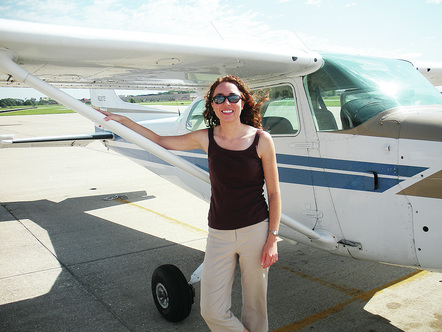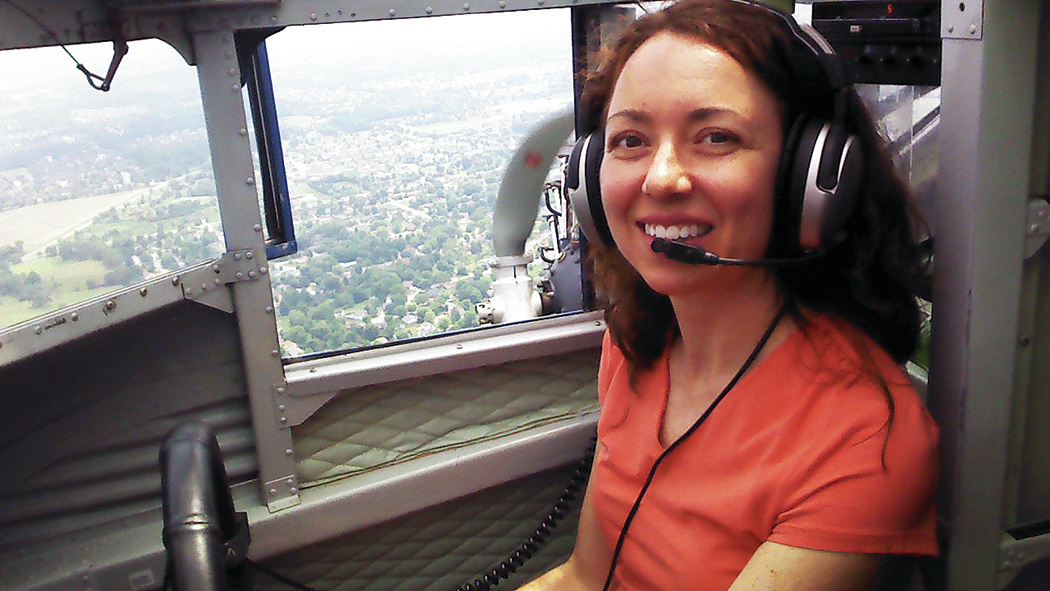 Melissa Pawley at Greenwood Municipal Airport in July 2009, when she soloed for the first time.
Melissa Pawley at Greenwood Municipal Airport in July 2009, when she soloed for the first time. Editor
When Melissa Pawley took off from the pilot’s seat of an airplane for the first time April 1, 2009, at Greenwood Municipal Airport, she flew into love.
“There is no experience like soaring through the air, free as a bird,” she said. “Flight is astounding to me – the fact that we can design bodies that are significantly heavier than air and then give them enough power to get airborne and stay in the air on relatively small wings is astounding. I enjoy participating in the feat and sharing it with others.
“When I take friends flying for the first time they are often amazed that I am able to fly and land the aircraft. I’m amazed as well.”
Pawley said she loves how open aviation is to all who are interested. “Although I am a distinct minority as a woman, I have never felt unwelcome. When I started my pilot training the airport regulars at Greenwood made a point of talking to me and encouraging me. They congratulated me after I soloed.
“The airport personnel has always treated me with respect and helped me when needed. I didn’t know when I started flying that I was becoming a member of a new community, but that’s what happens. Within the large aviation community there are families. I have a lot of ‘dads,’ some ‘brothers’ and a few new ‘sisters’ and ‘moms.’ ”
Pawley earned her license March 31, 2010, and is instrument rated, which means she is qualified to fly in the clouds.
“Many pilots and instructors like to say that the instrument rating gives them permission to fly in the clouds and the knowledge to avoid them because they don’t know what dangers lurk there. The rating requires a written test, flying a plane solely by referencing instruments, learning various maneuvers and a check ride.”
Pilots also learn to communicate with air traffic controllers during their initial training, especially when approaching runways that can’t be seen until just a few minutes before touchdown. Communications with controllers are more prevalent while working on the instrument rating.
While some Federal Aviation Administration-approved schools can train students in only 35 hours of flight time, most pilots in less stringent programs will log 60 to 70 hours of flight time before gaining their licenses. The variations in flight time affect the cost, but most schools estimate the average student spends between $7,000 and $10,000 to become licensed. Most training is done in single-engine aircraft, like a Cessna 172 or a Piper Warrior, both of which are fairly simple to fly, forgiving of errors and relatively inexpensive to rent and maintain.
Pawley enjoys flying so much that she quit her job as the library media specialist at Rosa Parks-Edison Elementary in May so she can prepare for the advanced ground instructor exam. Upon passing the test she can teach aspiring pilots, whether their goals are to fly for fun or continue through the airlines.
A graduate of Taylor University, Pawley taught science at Southport Middle School while working on her master’s degree. She transferred to Rosa Parks when it opened in 2003 and taught in Perry Township for 18 years.
“Although studying for the exam has been more challenging than I anticipated, I am learning a lot,” she said. “If I’m able to maintain my schedule of studying a couple hours each day, I expect to take it in the next week or two.
“I am also working with local Experimental Aircraft Association members to develop and teach additional courses for middle and high school students who are interested in various aspects of aviation,” she said.
Pawley doesn’t fly as often as she likes, in large part because she doesn’t own an aircraft. “However, my previous job was a barrier as well since I often didn’t have the mental sharpness by the end of a day of teaching to safely fly out of the area. Weather, though I’m certified to fly through clouds, is also a barrier. The continual rain and storms this spring and summer kept a lot of my fellow pilots on the ground. It’s been over a month since I’ve flown, but part of that is because I was out of town for a couple weeks.”
One of those weeks was spent at the Oshkosh AirVenture conference in Wisconsin, where thousands of aviation enthusiasts from around the world attended. “There were aircraft everywhere – from small gyrocopters (think mailman flying in on White House lawn) to historic war birds and large modern airliners,” she said. “It was a bit overwhelming, but I had great time.
“Airbus flew in its new 350, and it was huge. I was able to walk/crawl through some war planes, including the B-29 Flying Fortress, which was flown in the Pacific Theater during World War II and featured in the book/movie ‘Unbroken.’ The daily air shows featured the best acrobatic and military demonstration teams in the world.”
There were also workshops where participants could learn everything from how to sand the wood for their home-built aircraft to how to fly for the airlines, and vendors sold everything from aviation sunglasses to corporate jets.
Pawley said the event was an inspirational experience as she was able to talk to other pilots, learn from instructors and listen to women who have excelled in their aviation/science-related fields, from rocket scientists and engineers to the first woman astronaut to walk in space.
Pawley’s goal is to work full time in aviation education, but right now she’s in transition, working part time (substitute teaching among other things) to pay bills while focusing her energy on learning and gaining certifications.
“Whether I’ll become a certified flight instructor or keep my feet on the ground for instruction remains to be seen.”


 RSS Feed
RSS Feed